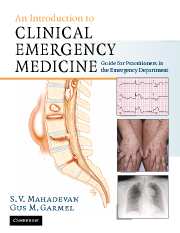Book contents
- Frontmatter
- Contents
- List of contributors
- Foreword
- Acknowledgments
- Dedication
- Section 1 Principles of Emergency Medicine
- 1 Approach to the emergency patient
- 2 Airway management
- 3 Cardiopulmonary and cerebral resuscitation
- 4 Cardiac dysrhythmias
- 5 Shock
- 6 Traumatic injuries
- 7 Prehospital care and emergency medical services
- 8 Pain management
- Section 2 Primary Complaints
- Section 3 Unique Issues in Emergency Medicine
- Section 4 Appendices
- Index
5 - Shock
Published online by Cambridge University Press: 27 October 2009
- Frontmatter
- Contents
- List of contributors
- Foreword
- Acknowledgments
- Dedication
- Section 1 Principles of Emergency Medicine
- 1 Approach to the emergency patient
- 2 Airway management
- 3 Cardiopulmonary and cerebral resuscitation
- 4 Cardiac dysrhythmias
- 5 Shock
- 6 Traumatic injuries
- 7 Prehospital care and emergency medical services
- 8 Pain management
- Section 2 Primary Complaints
- Section 3 Unique Issues in Emergency Medicine
- Section 4 Appendices
- Index
Summary
Scope of the problem
Shock is a state in which the oxygen (O2) and metabolic demands of the body are not met by the cardiac output. When this process occurs in a single organ, rather than throughout the body, organ ischemia and infarction ensue. When shock occurs on a more global level, multiorgan dysfunction and failure are the consequence, ultimately leading to death if not corrected. Shock is most often accompanied by hypotension, termed decompensated shock. However, shock may also occur with normal or elevated blood pressure. Examples include hypertensive emergency with compromised cardiac output, or carbon monoxide intoxication with the inability to deliver O2 despite normal hemodynamics. The approach to the patient in shock must proceed with the same urgency as the patient suffering from an acute myocardial infarction or cerebral vascular accident.
Classification
Shock states are classified according to the underlying physiologic derangement. Table 5.1 lists the most commonly used classification system. Hypovolemic shock is defined by decreased circulating blood volume, either due to blood or fluid loss, such that cardiac output is compromised. Impaired cardiac performance characterizes cardiogenic shock. Loss of vasomotor tone with hypotension is the hallmark of distributive shock, as in sepsis, anaphylaxis, or certain intoxications. Anatomic interruption of sympathetic output, usually secondary to spinal cord injury with disruption of the cervical sympathetic chain, leads to bradycardia and hypotension in neurogenic shock.
- Type
- Chapter
- Information
- An Introduction to Clinical Emergency MedicineGuide for Practitioners in the Emergency Department, pp. 85 - 92Publisher: Cambridge University PressPrint publication year: 2005



